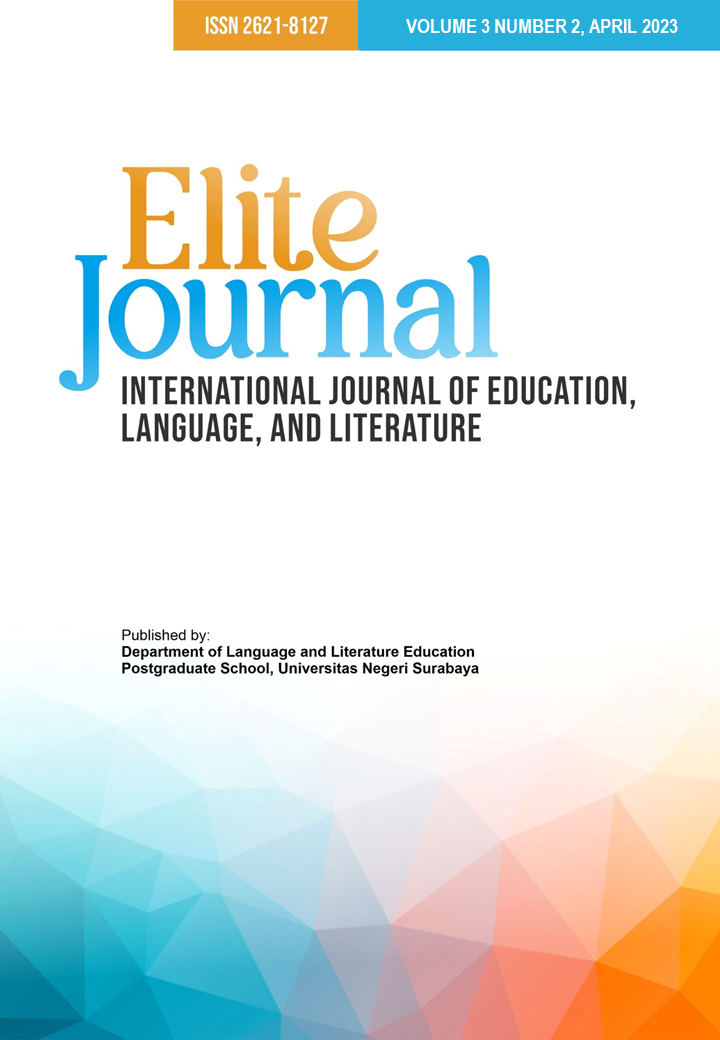USING MAKE A MATCH TECHNIQUE IN TEACHING DESCRIPTIVE TEXT TO THE SEVENTH GRADE STUDENTS OF SMP NEGERI 2 LUBUKLINGGAU
DOI:
https://doi.org/10.26740/elitejournal.v3n2.p109-121Keywords:
descriptive text, Make a Match technique, teaching.Abstract
The problem of this research was to answer whether it was significantly effective or not to use Make a Match technique in teaching Descriptive Text to the Seventh Grade Students of SMP Negeri 2 Lubuklinggau in the Academic Year 2022/2023. In addition, the objective in conducting this research was to find out the effectiveness of this technique in teaching descriptive text. Here, quasi-experimental research with total population 417 students was used by the researcher. Then, the researcher used cluster random sampling included 71 students from class VII.5 and VII.6. From the investigation which had been done by the researcher, it was found out that tobtained was 5.473 which was higher than ttable 1.667. It can be concluded that the null hypothesis (Ho) was rejected and the alternative hypothesis (Ha) was accepted. Finally, there was a significant difference achievement between students who were taught and were not taught by using Make a Match technique.
References
Arifah, M & Kusumarasdyati. (2013). The effectiveness of make a match technique for teaching writing descriptive text to the seventh grades of smpn 1 karangbinangun lamongan. Research on English Language Teaching in Indonesia, 1(1), 1-8.
Arikunto, S. (2014). Produr Penelitian suatu Pendekatan Praktik. Jakarta: PT Rineka Cipta.
Ary, D., Jacobs, L. C., Sorensen, C., & Razavieh, A. (2010). Introduction to Research in Education(8th ed.) Belmont: Wadsword Cengage Learning.
Creswell, J. W. (2012). Educational Research: planning, conducting and evaluating quantitative and qualitative research. Boston: Pearson Education.
Darmanto, P. (2017). Pendekatan Saintifik Kurikulum 2013. Klaten: Grafika Dua Tujuh.
Dirgantara, J, Sutarsyah, C & Supriyadi, D. (2013). Teaching reading of descriptive text through jigsaw at seventh grade of smpn 1 kedondong pesawaran. U-JET: Unila Journal of English Teaching, 2(6), 1-10.
Haryadi. (2017). Pendekatan Saintifik Kurikulum 2013. Klaten: Grafika Dua Tujuh.
Nikma, R. D, Gurning, B, & Husein, R. (2018). The effectiveness of make a match technique in teaching vocabulary. Advances In Social Science, Education and Humanities Research, 200, 596-599.
Silmi, M. R. (2017). Types of media and teaching yechniques in teaching speaking at smp brawijaya smart school malang. Suar Betang, 12(2), 223-233. DOI:10.26499/SURBET.V12I2.33
Sugiyono. (2019). Metode Penelitian Kuantitatif Kualitatif dan R&D (2nd ed.) Bandung: ALFABETA
Vabiola, & Fitrawati (2018).Teaching reading descriptive text by using tree mapping for senior high school students. Journal of English Language Teaching. 7(4), 741-754
Zulfahmi MD,S., Taknduklangi, A., & Mursalim. (2018). An analysis of lecturer perception on the use of e-learning for english instruction in IAIN Kendari. Journal of Language Education and Educational Technology, 3(2), 1-15. Accessedfrom: http://ojs.uho.ac.id/index.php/JLEET/article/download/6681/4913
Downloads
Published
How to Cite
Issue
Section
License
Copyright (c) 2023 Eka Fitriana, Ardayati, Dewi Syafitri

This work is licensed under a Creative Commons Attribution 4.0 International License.
 Abstract views: 185
,
Abstract views: 185
, PDF Downloads: 211
PDF Downloads: 211





